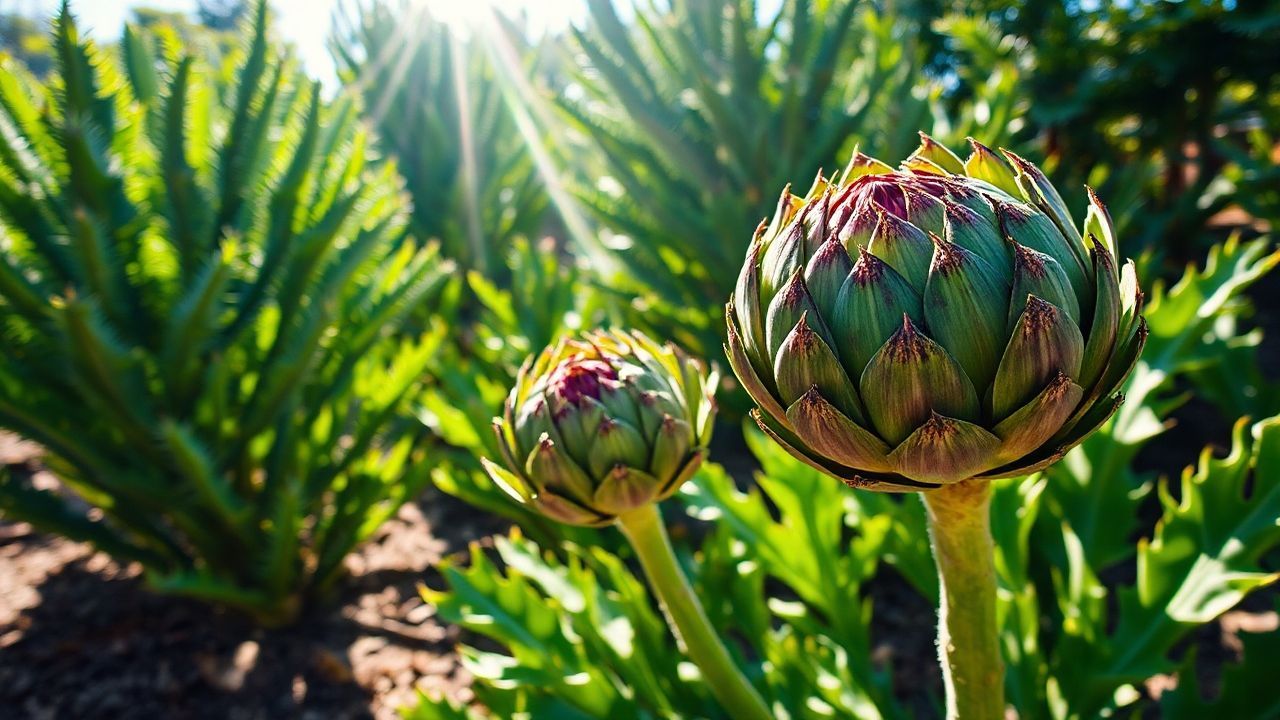Introduction to artichokes
Understanding artichoke growth
During the spring, artichokes produce flower stalks that emerge from the center of the plant. These stalks bear the flower heads, which are actually immature flower buds. The flower heads are protected by bracts, which are modified leaves that overlap like scales. As the flower heads mature, the bracts gradually open, revealing the delicate purple or blue florets within.
Artichokes typically bloom in the late spring or early summer, and the flower heads can be harvested over a long period. Once the flower heads have been removed, the plant will continue to produce new shoots and flower stalks throughout the season. In colder climates, artichokes may need to be overwintered indoors or protected with mulch to prevent frost damage.
By understanding the growth cycle of artichokes, home gardeners can successfully cultivate these unique and delicious vegetables. With proper care and attention, artichoke plants can provide a bountiful harvest for years to come.
Best conditions for growing artichokes
Artichokes are a perennial plant that can grow up to 6 feet tall. They have large, deeply lobed leaves and produce edible flower buds. Artichokes are native to the Mediterranean region and are now grown in many parts of the world.
To grow artichokes, you will need to start with a healthy plant. You can purchase artichoke plants from a nursery or grow them from seed. If you are starting from seed, you will need to sow the seeds indoors 6 to 8 weeks before the last frost. Once the seedlings have developed their first set of true leaves, you can transplant them outdoors.
When transplanting artichokes, space the plants 3 to 4 feet apart in well-drained soil. Water the plants deeply and mulch around them to help retain moisture. Artichokes require regular watering, especially during hot, dry weather.
Artichokes are heavy feeders and require regular fertilization. You can fertilize the plants with a balanced fertilizer every few weeks. Artichokes are susceptible to a few pests and diseases, including aphids, spider mites, and powdery mildew. To prevent these problems, it is important to keep the plants clean and well-maintained. With proper care, artichokes can produce large, flavorful buds for many years.
Planting and caring for artichokes
The planting process involves starting seeds indoors or purchasing small plants from a nursery. If starting from seeds, sow them in late winter or early spring, and transplant the seedlings outdoors after the last frost. Choose a planting site with full sun and well-drained soil. Artichokes prefer a soil pH of 6.0 to 6.5. Amend the soil with compost or organic matter to improve drainage and fertility. Plant the artichokes 3 to 4 feet apart, and water them deeply after planting.
Caring for artichokes is relatively straightforward. Water them regularly, especially during hot, dry weather. Fertilize them monthly with a balanced fertilizer. To encourage larger buds, remove any side shoots that appear on the plant. Artichokes are generally low-maintenance plants, but they may be susceptible to certain pests and diseases, such as aphids, mites, and powdery mildew. Regularly inspect the plants for signs of distress, and treat any issues promptly with appropriate organic or chemical remedies.
Harvesting artichokes
Artichokes are a unique and delicious vegetable that can be grown in many climates. They are a member of the sunflower family and are related to thistles. Artichokes are harvested when the buds are immature and have not yet opened. The buds are typically harvested when they are about 2-3 inches in diameter and have a tightly closed center.
To harvest artichokes, simply use a sharp knife to cut the stem about 1-2 inches below the bud. Be careful not to cut the bud itself. Once the artichoke is harvested, it should be stored in a cool, dark place until it is ready to be eaten. Artichokes can be eaten raw, cooked, or pickled. They are a versatile vegetable that can be used in a variety of dishes.
When harvesting artichokes, it is important to be patient. It can take several months for the buds to mature. However, the wait is worth it, as artichokes are a delicious and nutritious vegetable.
Conclusion: Grow delicious artichokes
Cultivating artichokes is a rewarding endeavor that offers a bountiful harvest of delectable and nutritious vegetables. By providing optimal growing conditions, including well-drained soil, ample sunlight, and consistent moisture, you can nurture thriving artichoke plants that will produce an abundance of succulent heads. Remember to protect your plants from pests and diseases by implementing appropriate control measures. With a little patience and care, you can enjoy the fruits of your labor and savor the delightful flavor of homegrown artichokes. Whether you choose to steam, roast, or grill them, the versatility of artichokes makes them a culinary delight that can be enjoyed in various ways. So, embrace the joy of growing your own artichokes, and experience the satisfaction of nurturing these extraordinary vegetables from seed to table.

Leave a Reply